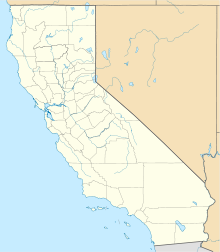Los Angeles International Airport

Los Angeles International Airport

Los Angeles International Airport | |||||||||||||||||||||||
|---|---|---|---|---|---|---|---|---|---|---|---|---|---|---|---|---|---|---|---|---|---|---|---|
 | |||||||||||||||||||||||
 | |||||||||||||||||||||||
| Summary | |||||||||||||||||||||||
| Airport type | Public | ||||||||||||||||||||||
| Owner | City of Los Angeles | ||||||||||||||||||||||
| Operator | Los Angeles World Airports | ||||||||||||||||||||||
| Serves | Los Angeles metropolitan area | ||||||||||||||||||||||
| Location | Los Angeles, California, U.S. | ||||||||||||||||||||||
| Opened | 1930 (1930) | ||||||||||||||||||||||
| Hub for | Passenger airlines
| ||||||||||||||||||||||
| Focus city for |
| ||||||||||||||||||||||
| Built | 1928 | ||||||||||||||||||||||
| Elevation AMSL | 128 ft / 39 m | ||||||||||||||||||||||
| Coordinates | 33°56′33″N 118°24′29″W [235] | ||||||||||||||||||||||
| Website | www.flylax.com [236] | ||||||||||||||||||||||
| Maps | |||||||||||||||||||||||
| Runways | |||||||||||||||||||||||
| |||||||||||||||||||||||
| Statistics | |||||||||||||||||||||||
| |||||||||||||||||||||||
Los Angeles International Airport (IATA: LAX, ICAO: KLAX, FAA LID: LAX), commonly referred to as LAX (with each of its letters pronounced individually), is the primary international airport serving Los Angeles, California, United States, and its surrounding metropolitan area.
LAX is located in the Westchester neighborhood of Los Angeles in California, 18 miles (30 km) southwest of Downtown Los Angeles, with the commercial and residential areas of Westchester to the north, the city of El Segundo to the south and the city of Inglewood to the east. Owned and operated by Los Angeles World Airports (LAWA), an agency of the government of Los Angeles, formerly known as the Department of Airports, the airport covers 3,500 acres (1,400 ha) of land. LAX has four parallel runways.[5]
In 2018, LAX handled 87,534,384 passengers, making it the world's fourth busiest and the United States' second busiest airport following Hartsfield-Jackson Atlanta International Airport. As the largest and busiest international airport on the U.S. West Coast, LAX is a major international gateway to the United States, and also serves a connection point for passengers traveling internationally. The airport holds the record for the world's busiest origin and destination airport, since relative to other airports, many more travelers begin or end their trips in Los Angeles than use it as a connection. It is also the only airport to rank among the top five U.S. airports for both passenger and cargo traffic.[8]
LAX serves as a hub or focus city for more passenger airlines than any other airport in the United States. It is the only airport that four U.S. legacy carriers (Alaska, American, Delta, and United) have designated as a hub and is a focus city for Air New Zealand, Allegiant Air, Norwegian Air Shuttle, Qantas, Southwest Airlines, and Volaris. While LAX is the busiest airport in the Greater Los Angeles Area, several other airports, including Hollywood Burbank Airport, John Wayne Airport, Long Beach Airport, as well as Ontario International Airport, also serve the area.
Los Angeles International Airport | |||||||||||||||||||||||
|---|---|---|---|---|---|---|---|---|---|---|---|---|---|---|---|---|---|---|---|---|---|---|---|
 | |||||||||||||||||||||||
 | |||||||||||||||||||||||
| Summary | |||||||||||||||||||||||
| Airport type | Public | ||||||||||||||||||||||
| Owner | City of Los Angeles | ||||||||||||||||||||||
| Operator | Los Angeles World Airports | ||||||||||||||||||||||
| Serves | Los Angeles metropolitan area | ||||||||||||||||||||||
| Location | Los Angeles, California, U.S. | ||||||||||||||||||||||
| Opened | 1930 (1930) | ||||||||||||||||||||||
| Hub for | Passenger airlines
| ||||||||||||||||||||||
| Focus city for |
| ||||||||||||||||||||||
| Built | 1928 | ||||||||||||||||||||||
| Elevation AMSL | 128 ft / 39 m | ||||||||||||||||||||||
| Coordinates | 33°56′33″N 118°24′29″W [235] | ||||||||||||||||||||||
| Website | www.flylax.com [236] | ||||||||||||||||||||||
| Maps | |||||||||||||||||||||||
| Runways | |||||||||||||||||||||||
| |||||||||||||||||||||||
| Statistics | |||||||||||||||||||||||
| |||||||||||||||||||||||
History
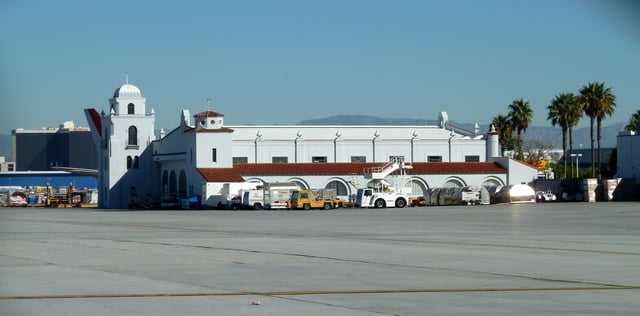
Hangar No. 1 was the first structure at LAX, built in 1929, restored in 1990 and remaining in active use.[9]

Los Angeles Municipal Airport on Army Day, c. 1931
In 1928, the Los Angeles City Council selected 640 acres (1.00 sq mi; 260 ha) in the southern part of Westchester for a new airport. The fields of wheat, barley and lima beans were converted into dirt landing strips without any terminal buildings. It was named Mines Field for William W. Mines, the real estate agent who arranged the deal.[10] The first structure, Hangar No. 1, was erected in 1929 and is in the National Register of Historic Places.[11]
Mines Field opened as the airport of Los Angeles in 1930 and the city purchased it to be a municipal airfield in 1937. The name became Los Angeles Airport in 1941 and Los Angeles International Airport in 1949.[12] In the 1930s the main airline airports were Burbank Airport (then known as Union Air Terminal, and later Lockheed) in Burbank and the Grand Central Airport in Glendale. (In 1940 the airlines were all at Burbank except for Mexicana's three departures a week from Glendale; in late 1946 most airline flights moved to LAX, but Burbank always retained a few.)[13]
Mines Field did not extend west of Sepulveda Boulevard;[14] Sepulveda was rerouted circa 1950 to loop around the west ends of the extended east–west runways (now runways 25L and 25R), which by November 1950 were 6,000 feet (1,800 m) long.[15] A tunnel was completed in 1953 allowing Sepulveda Boulevard to revert to straight and pass beneath the two runways; it was the first tunnel of its kind. For the next few years the two runways were 8,500 feet (2,600 m) long.[12][16]
The "X" in LAX
Before the 1930s, existing airports used a two-letter abbreviation based on the weather stations at the airports. At that time, "LA" served as the designation for Los Angeles Airport. But with the rapid growth in the aviation industry the designations expanded to three letters c. 1947, and "LA" became "LAX." The letter "X" has no specific meaning in this identifier (just like the X in DXB - Dubai).[17] "LAX" is also used for the Port of Los Angeles in San Pedro and by Amtrak for Union Station in downtown Los Angeles.
Aircraft spotting
The "Imperial Hill" area in El Segundo is a prime location for aircraft spotting, especially for takeoffs. Part of the Imperial Hill area has been set aside as a city park, Clutter's Park [237] .
Another popular spotting location sits under the final approach for runways 24 L&R on a lawn next to the Westchester In-N-Out Burger on Sepulveda Boulevard. This is one of the few remaining locations in Southern California from which spotters may watch such a wide variety of low-flying commercial airliners from directly underneath a flight path.
One can also do aircraft spotting at a small park in the take-off pattern that (normally) goes out over the Pacific. The park is on the East side of the street Vista Del Mar from where it takes its name, Vista Del Mar Park.
Space Shuttle Endeavour
At 12:51 p.m. on Friday, September 21, 2012, a Shuttle Carrier Aircraft carrying the Space Shuttle Endeavour landed at LAX on runway 25L.[18] An estimated 10,000 people saw the shuttle land. Interstate 105 was backed up for miles at a standstill. Imperial Highway was shut down for spectators. It was quickly taken off the Shuttle Carrier Aircraft, a modified Boeing 747, and was moved to a United Airlines hangar. The shuttle spent about a month in the hangar while it was prepared to be transported to the California Science Center.
Theme Building

LAX Theme Building, July 1962
The distinctive white Googie Theme Building, designed by Pereira & Luckman architect Paul Williams and constructed in 1961 by Robert E. McKee Construction Co., resembles a flying saucer that has landed on its four legs. A restaurant with a sweeping view of the airport is suspended beneath two arches that form the legs. The Los Angeles City Council designated the building a Los Angeles Historic-Cultural Monument in 1992. A $4 million renovation, with retro-futuristic interior and electric lighting designed by Walt Disney Imagineering, was completed before the Encounter Restaurant opened there in 1997 but is no longer in business.[19] Visitors are able to take the elevator up to the Observation Deck of the "Theme Building", which closed after the September 11, 2001 attacks for security reasons and reopened to the public on weekends beginning on July 10, 2010. Although, as of April 2019, the hours of operation had not been consistent as the Observation Deck had been not been open at all during weekends.[20] Additionally, a memorial to the victims of the 9/11 attacks is located on the grounds, as three of the four hijacked planes were originally destined for LAX.[21] The Bob Hope USO expanded and relocated to the first floor of the Theme Building in 2018.[22]
Runways

LAX from El Segundo, with Imperial Highway in the foreground
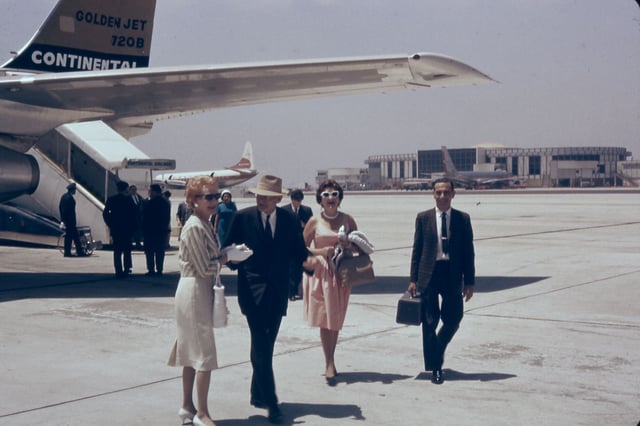
Continental passengers arriving at CAL terminal, July 1962, before jet-ways were constructed.
24R/06L and 24L/06R (designated the North Airfield Complex) are north of the airport terminals, and 25R/07L and 25L/07R (designated the South Airfield Complex) are south of the airport terminals.
| E | Length | Width | W |
|---|---|---|---|
| 06L → | 8,926 ft 2,721 m | 150 ft 46 m | ← 24R |
| 06R → | 10,885 ft 3,318 m | 150 ft 46 m | ← 24L |
| Terminal Area | |||
| 07L → | 12,923 ft 3,939 m | 150 ft 46 m | ← 25R |
| 07R → | 11,095 ft 3,382 m | 200 ft 61 m | ← 25L |
Since 1972, Los Angeles World Airports has adopted the "Preferential Runway Use Policy" to minimize noise. During daylight hours (0630 to 0000), the normal air traffic pattern is the "Westerly Operations" plan, named for the prevailing west winds. Under "Westerly Operations", departing aircraft take off to the west, and arriving aircraft approach from the east. To reduce noise from arriving aircraft during night hours (0000 to 0630), the air traffic pattern becomes "Over-Ocean Operations". Under "Over-Ocean", departing aircraft continue to take off to the west, but arriving aircraft approach from the west unless otherwise required to approach from the east due to reduced visibility or easterly winds. As the name implies, "Easterly Operations" is used when prevailing winds have shifted to originate from the east, typically during inclement weather and Santa Ana conditions. Under "Easterly Operations", departing aircraft take off to the east, and arriving aircraft approach from the west.[23]
The "inboard" runways (06R/24L and 07L/25R, closest to the central terminal area) are preferred for departures, and the "outboard" runways are preferred for arrivals. During noise-sensitive hours (2200 to 0700) and "Over-Ocean Operations", the "inboard" runways are used preferentially, with arrivals shifting primarily to 06R/24L and departures from 07L/25R. Historically, over 90% of flights have used the "inboard" departures and "outboard" arrivals scheme.[23]
During westbound operations during the daytime, airplanes parked on the north complex tend to use Runway 6R/24L for almost all departures, and airplanes parked on the south complex use Runway 7L/25R for all departures requiring the left turn, and Runway 24L if they are making an immediate right turn. For arrivals, flights coming from the north tend to use Runway 6L/24R, and flights coming from the south tend to use Runway 7R/25L. For flights having a long final westbound, it could depend.
The South Airfield Complex tends to see more operations than the North, due to a larger number of passenger gates and air cargo operations.[23] Runways in the North Airfield Complex are separated by 700 feet (210 m).[24] Plans have been advanced and approved to increase the separation by 260 feet (79 m), which would allow a central taxiway between runways, despite opposition from residents living north of LAX.[25] The separation between the two runways in the South Airfield Complex has already increased by 55 feet (17 m) to accommodate a central taxiway.[26][27]
Terminals
LAX has nine passenger terminals with a total of 132 gates arranged in the shape of the letter U or a horseshoe. The terminals are served by a shuttle bus. The Tom Bradley International Terminal and Terminals 4, 5, 6, 7, and 8 are all connected airside via an overground passage between Terminal 4 and the Tom Bradley International Terminal, an underground tunnel between Terminals 4, 5, and 6 and above-ground walkways between Terminals 6, 7, and 8. Additional airside shuttle buses operate among Terminals 4, 5, and the American Eagle remote terminal, as well as between Terminals 2, 3, and the Tom Bradley International Terminal. There are no physical airside connections between any of the other terminals. In addition to these terminals, there are 2,000,000 square feet (190,000 m2) of cargo facilities at LAX, and a heliport operated by Bravo Aviation.
Airlines and destinations
Passenger
| Airlines | Destinations | Refs |
|---|---|---|
| Aer Lingus | Dublin | [28] |
| Aeroflot | Moscow–Sheremetyevo | [29] |
| Aeroméxico | Guadalajara, Mexico City | [30] |
| Aeroméxico Connect | León/Del Bajío, Monterrey | [30] |
| Air Canada | Calgary, Montréal–Trudeau, Toronto–Pearson, Vancouver | [31] |
| Air China | Beijing–Capital, Shenzhen | [32] |
| Air France | Papeete, Paris–Charles de Gaulle | [33] |
| Air Italy | Seasonal: Milan–Malpensa[34] | [35] |
| Air New Zealand | Auckland, London–Heathrow, Rarotonga | [36] |
| Air Tahiti Nui | Papeete, Paris–Charles de Gaulle | [37] |
| Alaska Airlines | Anchorage, Baltimore, Boise (begins March 19, 2020),[38] Boston, Chicago–O'Hare, Dallas–Love, Everett, Fort Lauderdale, Guadalajara, Honolulu, Ixtapa/Zihuatanejo, Kahului, Las Vegas, Liberia (CR), Loreto, Manzanillo, Mazatlán, Missoula (begins March 19, 2020),[38] New York–JFK, Newark, Philadelphia (ends November 4, 2019),[38] Portland (OR), Puerto Vallarta, Redmond/Bend (begins January 7, 2020),[38] Salt Lake City, San Francisco, San Jose (CA), San José del Cabo, San José (CR), Santa Rosa, Seattle/Tacoma, Spokane (begins January 7, 2020),[38] Washington–Dulles, Washington–National | [39] |
| Alitalia | Rome–Fiumicino | [40] |
| All Nippon Airways | Tokyo–Haneda, Tokyo–Narita | [41] |
| Allegiant Air | Bellingham, Boise, Cincinnati, Eugene, Medford, Memphis, Provo, Springfield (MO), Tulsa Seasonal: Billings, Bozeman, Cedar Rapids/Iowa City, Des Moines, Fargo, Fayetteville/Bentonville, Glacier Park/Kalispell, Grand Junction, Great Falls, Idaho Falls, Las Vegas, Little Rock, McAllen, Missoula, Montrose, Oklahoma City, Sioux Falls, Tri-Cities (WA), Wichita | [42] |
| American Airlines | Atlanta, Austin, Beijing–Capital, Belize City, Boston, Buenos Aires–Ezeiza, Charlotte, Chicago–O'Hare, Columbus–Glenn, Dallas/Fort Worth, Hartford, Hong Kong, Honolulu, Houston–Intercontinental, Indianapolis, Kahului, Kailua–Kona, Las Vegas, Lihue, London–Heathrow, Louisville, Mexico City, Miami, Nashville, New Orleans, New York–JFK, Orlando, Philadelphia, Phoenix–Sky Harbor, Raleigh/Durham, St. Louis, San Antonio, San Francisco, San José del Cabo, São Paulo–Guarulhos, Shanghai–Pudong, Sydney, Tucson, Tokyo–Haneda, Tokyo–Narita (ends March 30, 2020),[43] Washington–Dulles, Washington–National Seasonal: Anchorage, Auckland, Eagle/Vail, Memphis (begins December 18, 2019)[44] | [45] |
| American Eagle | Albuquerque, Denver, El Paso, Eugene, Fayetteville/Bentonville, Fresno, Houston–Intercontinental, Mazatlán, Medford, Montrose, Oklahoma City, Omaha, Phoenix–Sky Harbor, Portland (OR), Puerto Vallarta, Redmond-Bend, Reno/Tahoe, Sacramento, Salt Lake City, San Antonio, San Diego, San Francisco, San Jose (CA), Seattle/Tacoma, Tucson, Tulsa, Vancouver Seasonal: Aspen, Bozeman (resumes June 4, 2020)[46] Durango (CO), Flagstaff, Glacier Park/Kalispell, Jackson Hole, Santa Rosa | [45] |
| Asiana Airlines | Seoul–Incheon | [47] |
| Austrian Airlines | Seasonal: Vienna | [48] |
| Avianca | Bogotá | [49] |
| Avianca Costa Rica | Guatemala City, San José (CR), San Salvador | [49] |
| Avianca El Salvador | San Salvador | [49] |
| Boutique Air | Merced | [50] |
| British Airways | London–Heathrow | [51] |
| Cathay Pacific | Hong Kong | [52] |
| China Airlines | Taipei–Taoyuan | [53] |
| China Eastern Airlines | Chengdu, Nanjing, Shanghai–Pudong | [54] |
| China Southern Airlines | Guangzhou, Shenyang | [55] |
| Copa Airlines | Panama City–Tocumen | [56] |
| Delta Air Lines | Atlanta, Austin, Boston, Cancún, Cincinnati, Columbus–Glenn, Dallas/Fort Worth, Denver, Detroit, Guatemala City, Honolulu, Indianapolis, Kahului, Kailua–Kona, Kansas City, Las Vegas, Lihue, Memphis, Mexico City, Minneapolis/St. Paul, Nashville, New Orleans, New York–JFK, Orlando, Paris–Charles de Gaulle, Portland (OR), Puerto Vallarta, Raleigh/Durham, Sacramento, Salt Lake City, San Diego, San Francisco, San José del Cabo, San José (CR), Seattle/Tacoma, Shanghai–Pudong, Sydney, Tampa, Tokyo–Haneda, Washington–National Seasonal: Bozeman, Liberia (CR) | [57] |
| Delta Connection | Albuquerque, Boise, Las Vegas, Omaha (begins November 10, 2019),[58] Phoenix–Sky Harbor, Sacramento, San Antonio, San Diego, San Jose (CA), Spokane, Tucson Seasonal: Bozeman, Jackson Hole, Missoula | [57] |
| El Al | Tel Aviv | [59] |
| Emirates | Dubai–International | [60] |
| Etihad Airways | Abu Dhabi | [61] |
| EVA Air | Taipei–Taoyuan | [62] |
| Fiji Airways | Nadi | [63] |
| Finnair | Helsinki | [64] |
| Frontier Airlines | Atlanta, Denver, Las Vegas Seasonal: Cincinnati | [65] |
| Hainan Airlines | Changsha, Chengdu, Chongqing, Xi'an | [66] |
| Hawaiian Airlines | Honolulu, Kahului, Kailua–Kona, Lihue | [67] |
| Hong Kong Airlines | Hong Kong | [68] |
| Iberia | Madrid | [69] |
| Interjet | Cancún (ends October 26, 2019),[70] Guadalajara, Mexico City | [71] |
| Japan Airlines | Osaka–Kansai, Tokyo–Narita | [72] |
| JetBlue | Boston, Buffalo, Fort Lauderdale, New York–JFK, Orlando | [73] |
| KLM | Amsterdam | [74] |
| Korean Air | Seoul–Incheon | [75] |
| LATAM Chile | Lima, Santiago | [76] |
| LATAM Perú | Lima | [76] |
| LOT Polish Airlines | Warsaw–Chopin | [77] |
| Lufthansa | Frankfurt, Munich | [78] |
| Mokulele Airlines | El Centro | [79] |
| Norwegian Air Shuttle | Barcelona, London–Gatwick, Madrid, Paris–Charles de Gaulle Seasonal: Copenhagen, Oslo–Gardermoen, Rome–Fiumicino, Stockholm–Arlanda | [80] |
| Philippine Airlines | Manila | [81] |
| Qantas[1] | Brisbane, Melbourne, Sydney | [82] |
| Qatar Airways | Doha | [83] |
| Saudia | Jeddah, Riyadh | [84] |
| Scandinavian Airlines | Copenhagen (resumes January 13, 2020),[85] Stockholm–Arlanda (ends January 12, 2020) | [86] |
| Sichuan Airlines | Chengdu, Hangzhou, Jinan | [87] |
| Singapore Airlines | Singapore, Tokyo–Narita | [88] |
| Southwest Airlines | Albuquerque, Atlanta, Austin, Baltimore, Cancún (ends January 5, 2020),[89] Chicago–Midway, Dallas–Love, Denver, El Paso, Houston–Hobby, Kansas City, Las Vegas, Nashville, New Orleans, Oakland, Omaha (ends January 5, 2020),[89] Phoenix–Sky Harbor, Pittsburgh (ends January 5, 2020),[89] Portland (OR), Puerto Vallarta (ends January 5, 2020),[89] Reno/Tahoe, Sacramento, St. Louis, Salt Lake City, San Antonio, San Francisco, San Jose (CA), San José del Cabo, Tucson **Seasonal:**Indianapolis, Milwaukee, Tampa | [90] |
| Spirit Airlines | Atlanta, Austin, Baltimore, Chicago–O'Hare, Cleveland, Dallas/Fort Worth, Denver, Detroit, Fort Lauderdale, Houston–Intercontinental, Kansas City, Las Vegas, Minneapolis/St. Paul, New Orleans, Oakland, Philadelphia, Pittsburgh | [91] |
| Sun Country Airlines | Minneapolis/St. Paul Seasonal: Honolulu, Las Vegas, Nashville | [92] |
| Swiss International Air Lines | Zurich | [93] |
| Turkish Airlines | Istanbul | [94] |
| United Airlines | Boston, Cancún, Chicago–O'Hare, Cleveland, Denver, Hilo, Honolulu, Houston–Intercontinental, Kahului, Kailua–Kona, Las Vegas, Lihue, London–Heathrow, Melbourne, Newark, Orlando, San Diego, San Francisco, Seattle/Tacoma, Shanghai–Pudong, Sydney, Tokyo–Haneda (begins March 28, 2020),[95] Tokyo–Narita, Washington–Dulles Seasonal: Baltimore, Phoenix–Sky Harbor, Puerto Vallarta, San José del Cabo, Vancouver | [96] |
| United Express | Austin, Boise, Bozeman, Colorado Springs, Eugene, Eureka, Fresno, Las Vegas, Madison, Medford, Monterey, Palm Springs, Phoenix–Sky Harbor, Prescott, Redding, Redmond, Reno/Tahoe, Sacramento, Salt Lake City, San Antonio, San Diego, San Francisco, San Luis Obispo, Santa Barbara, Seattle/Tacoma, St. George (UT), Stockton, Tri-Cities (WA), Vancouver Seasonal: Aspen, Eagle/Vail, Glacier Park/Kalispell, Hayden/Steamboat Springs, Jackson Hole, Mammoth Lakes, Missoula, Montrose, Rapid City, Sun Valley | [96] |
| Virgin Atlantic | London–Heathrow Seasonal: Manchester (UK) | [97] |
| Virgin Australia | Brisbane, Melbourne, Sydney | [98] |
| VivaAerobus | Guadalajara Seasonal: Monterrey | [99] |
| Volaris | Aguascalientes, Durango, Guadalajara, León/Del Bajío, Mexico City, Morelia, Oaxaca, Uruapan, Zacatecas | [100] |
| Volaris Costa Rica | Guatemala City, San José (CR), San Salvador | [101] |
| WestJet | Calgary, Edmonton, Toronto–Pearson, Vancouver | [102] |
| XiamenAir | Qingdao, Xiamen | [103] |
Cargo
| Airlines | Destinations | Refs |
|---|---|---|
| AeroUnion | Guadalajara, León/El Bajío, Mexico City, Monterrey | [104] |
| AirBridgeCargo Airlines | Amsterdam, Anchorage, Hong Kong, Shanghai–Pudong | [105] |
| Air China Cargo | Beijing–Capital, Quito, Shanghai–Pudong | [106][107] |
| Aloha Air Cargo | Honolulu | [108] |
| Asiana Cargo | Anchorage, San Francisco, Seoul–Incheon | [109] |
| Cargolux | Anchorage, Calgary, Glasgow–Prestwick, Indianapolis, Luxembourg, Mexico City, Milan–Malpensa, Seattle/Tacoma | [110][111] |
| Cathay Pacific Cargo | Anchorage, Hong Kong, Mexico City, Portland (OR)[112] | [113] |
| China Airlines Cargo | Anchorage, Osaka, San Francisco, Taipei–Taoyuan | [114][115][116] |
| China Cargo Airlines | Shanghai–Pudong | [117] |
| China Southern Cargo | Guangzhou, Hefei, Shanghai–Pudong, Tianjin, Vancouver, Zhengzhou | [118][119][120] |
| DHL Aviation | Anchorage, Calgary, Cincinnati, Guadalajara, Hong Kong, Honolulu, Huatulco, Leipzig/Halle, Mexico City, Phoenix–Sky Harbor, Portland (OR), San Francisco, San Jose (CA), San José (CR), Seattle/Tacoma, Seoul–Incheon, Tokyo–Narita, Tucson, Vancouver | [108][121][122][123][124][125] |
| Emirates SkyCargo | Copenhagen, Dubai–Al Maktoum, Mexico City, Zaragoza | [126][127] |
| EVA Air Cargo | Anchorage, Taipei–Taoyuan | [128] |
| FedEx Express | Boston, Burbank, Chicago–O'Hare, Dallas/Fort Worth, Edmonton, Fort Worth/Alliance, Fresno, Honolulu, Indianapolis, Memphis, Miami, Minneapolis/St. Paul, Nashville, Newark, Oakland, Ontario, Orange County, Phoenix–Sky Harbor, Portland (OR), San Diego, Seattle/Tacoma, Sydney, Tulsa Seasonal: Hartford | |
| Korean Air Cargo | Anchorage, San Francisco, Seoul–Incheon, Tokyo–Narita | [129][130] |
| LATAM Cargo Mexico | Campinas–Viracopos, Guadalajara, Miami, Mérida, Mexico City, Quito | [131] |
| Lufthansa Cargo | Frankfurt, Manchester | [132] |
| National Airlines (N8) | Anchorage, Nagoya–Centrair, Shanghai–Pudong | [133] |
| Nippon Cargo Airlines | San Francisco, Tokyo–Narita | [134][135] |
| Qantas Freight | Auckland, Chongqing, Honolulu, Melbourne, Sydney | [136] |
| Qatar Airways Cargo | Doha, Luxembourg, Mexico City | [137][138][139][140] |
| Singapore Airlines Cargo | Amsterdam, Anchorage, Brussels, Hong Kong, Sharjah | [141] |
| Sky Lease Cargo | Miami, Tokyo–Narita | [142] |
| UPS Airlines | Dallas/Fort Worth, Louisville, Ontario, Orlando | |
| Western Global Airlines | Hong Kong | [143] |
Traffic and statistics
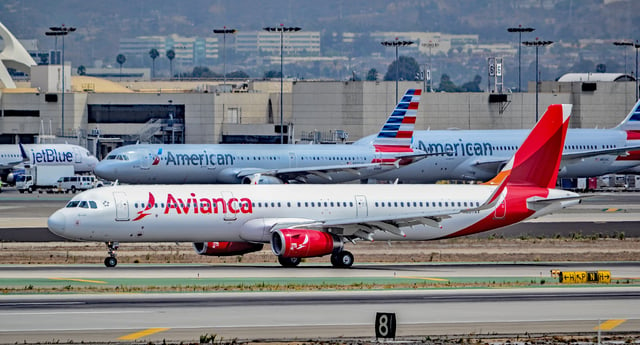
An Avianca Airbus A321 with numerous American Airlines aircraft in the background
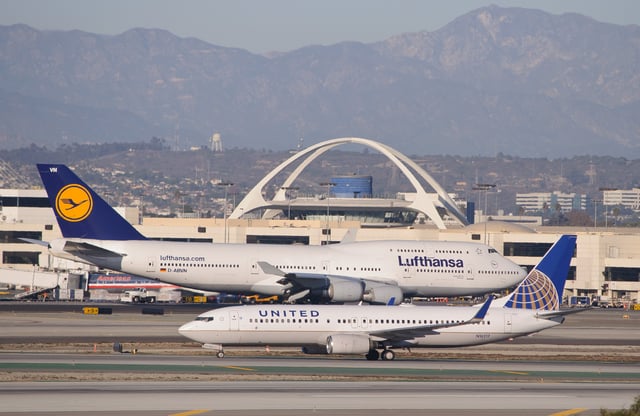
A United 737-800 and A Lufthansa 747-400 taxiing
It is the world's fourth-busiest airport by passenger traffic and eleventh-busiest by cargo traffic,[144] serving over 87 million passengers and 2 million tons of freight and mail in 2014. It is the busiest airport in the state of California, and the second-busiest airport by passenger boardings in the United States. In terms of international passengers, the second busiest airport for international traffic in the United states, behind only JFK in New York City. The number of aircraft movements (landings and takeoffs) was 700,362 in 2017, the third most of any airport in the world.
| Passenger volume | Aircraft movements | Freight (tons) | Mail (tons) | |
|---|---|---|---|---|
| 1994 | 51,050,275 | 689,888 | 1,516,567 | 186,878 |
| 1995 | 53,909,223 | 732,639 | 1,567,248 | 193,747 |
| 1996 | 57,974,559 | 763,866 | 1,696,663 | 194,091 |
| 1997 | 60,142,588 | 781,492 | 1,852,487 | 212,410 |
| 1998 | 61,215,712 | 773,569 | 1,787,400 | 264,473 |
| 1999 | 64,279,571 | 779,150 | 1,884,526 | 253,695 |
| 2000 | 67,303,182 | 783,433 | 2,002,614 | 246,538 |
| 2001 | 61,606,204 | 738,433 | 1,779,065 | 162,629 |
| 2002 | 56,223,843 | 645,424 | 1,869,932 | 92,422 |
| 2003 | 54,982,838 | 622,378 | 1,924,883 | 97,193 |
| 2004 | 60,704,568 | 655,097 | 2,022,911 | 92,402 |
| 2005 | 61,489,398 | 650,629 | 2,048,817 | 88,371 |
| 2006 | 61,041,066 | 656,842 | 2,022,687 | 80,395 |
| 2007 | 62,438,583 | 680,954 | 2,010,820 | 66,707 |
| 2008 | 59,815,646 | 622,506 | 1,723,038 | 73,505 |
| 2009 | 56,520,843 | 544,833 | 1,599,782 | 64,073 |
| 2010 | 59,069,409 | 575,835 | 1,852,791 | 74,034 |
| 2011 | 61,862,052 | 603,912 | 1,789,204 | 80,442 |
| 2012 | 63,688,121 | 605,480 | 1,867,155 | 88,438 |
| 2013 | 66,667,619 | 614,917 | 1,848,764 | 77,286 |
| 2014 | 70,662,212 | 636,706 | 1,921,302 | 79,850 |
| 2015 | 74,936,256 | 655,564 | 2,047,197 | 94,299 |
| 2016 | 80,921,527 | 697,138 | 2,105,941 | 99,394 |
| 2017 | 84,557,968 | 700,362 | 2,279,878 | 109,596 |
| 2018 | 87,534,384 | 707,833 | 2,336,443 | 109,694 |
| Source: Los Angeles World Airports[145] | ||||
Top domestic destinations
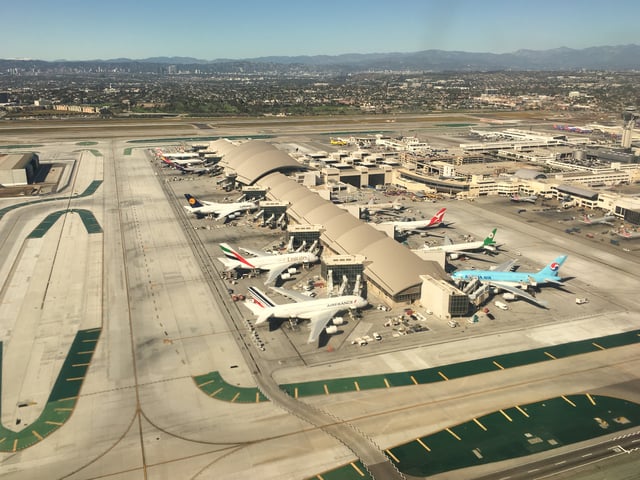
A number of international carriers shown at Tom Bradley International Terminal.
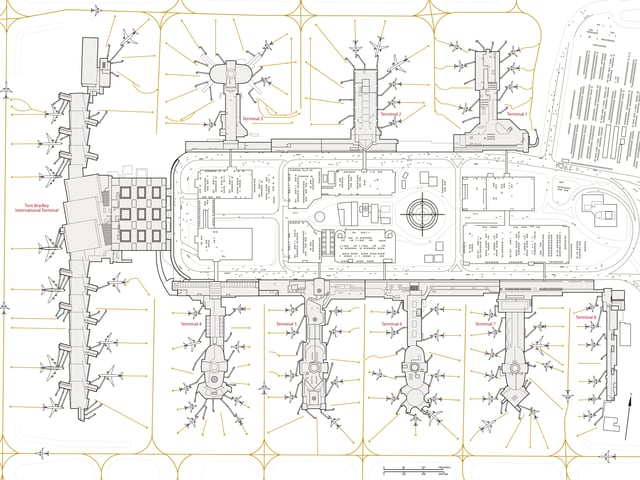
Los Angeles airport diagram of terminals
| Rank | Airport | Passengers | Carriers |
|---|---|---|---|
| 1 | 1,896,790 | Alaska, American, Delta, Southwest, United | |
| 2 | 1,748,400 | Alaska, American, Delta, JetBlue | |
| 3 | 1,526,440 | Alaska, Allegiant, American, Delta, Southwest, Spirit, United | |
| 4 | 1,433,410 | Alaska, American, Frontier, Spirit, United | |
| 5 | 1,237,540 | Alaska, American, Delta, Spirit, United | |
| 6 | 1,157,500 | Alaska, American, Delta, Hawaiian, Sun Country, United | |
| 7 | 1,153,670 | American, Delta, Spirit, United | |
| 8 | 1,124,180 | American, Delta, Frontier, Southwest, Spirit | |
| 9 | 1,110,630 | American, Delta, Frontier, Southwest, Spirit, United | |
| 10 | 865,290 | Alaska, United |
Top international destinations
| Rank | Airport | Passengers | Change 2017/2018 | Carriers |
|---|---|---|---|---|
| 1 | 1,626,448 | Air New Zealand, American Airlines, British Airways, United, Virgin Atlantic | ||
| 2 | 1,205,870 | Aeroméxico, American, Delta, Interjet, Volaris | ||
| 3 | 1,184,160 | Asiana, Korean Air | ||
| 4 | 1,094,555 | American, Cathay Pacific, Hong Kong Airlines | ||
| 5 | 976,159 | Aeroméxico, Alaska, Interjet, VivaAerobus, Volaris | ||
| 6 | 922,575 | American Airlines, Delta, Qantas, United, Virgin Australia | ||
| 7 | 912,890 | Air Canada, American, United, WestJet | ||
| 8 | 868,925 | ANA, American, JAL, Singapore Airlines, United | ||
| 9 | 866,480 | Air Canada, WestJet | ||
| 10 | 857,257 | China Airlines, EVA Air | ||
| 11 | 838,593 | American, China Eastern, Delta, United | ||
| 12 | 818,608 | Air France, Air Tahiti Nui, Delta, Norwegian, XL Airways France |
Airline market share
| Rank | Airline | Passengers | Share |
|---|---|---|---|
| 1 | American Airlines | 12,017,000 | 19.89% |
| 2 | Delta Air Lines | 10,920,000 | 18.07% |
| 3 | Southwest Airlines | 9,680,000 | 16.02% |
| 4 | United Airlines | 9,126,000 | 15.10% |
| 5 | Alaska Airlines | 5,354,000 | 8.86% |
Ground transportation
Transportation between terminals
Shuttles operate to and from the terminals, providing frequent service for connecting passengers. However, connecting passengers who use these shuttles must leave and then later reenter security.
Airside connectors

One of the large LAX signs that greet visitors to Los Angeles International Airport. This sign is at the Century Boulevard entrance to the airport.
Underground tunnels connect between terminals 4, 5, 6, 7, and 8, and an above-ground connector between TBIT and terminal 4 opened in February 2016.[149]
Freeways and roads
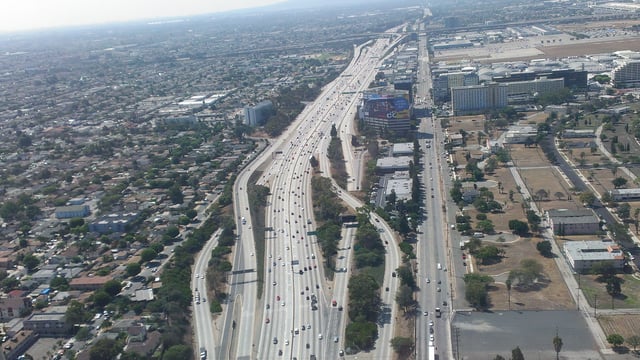
The 405 freeway near LAX
LAX's terminals are immediately west of the interchange between Century Boulevard and Sepulveda Boulevard (State Route 1). The 405 Freeway can be reached to the east via Century Boulevard, and the 105 Freeway can be reached to the south via Sepulveda Boulevard. Sepulveda Boulevard also goes right under the airport runways.
Bus

LAX City Bus Center
The closest bus stops to the terminals are the pair of opposites on Sepulveda Boulevard and Century Boulevard, served by Metro 117, Torrance 8, Metro 232, Commuter Express 574, Metro 102 to USC and the Metro Expo line, and Metro 40 to Los Angeles Union Station (owl service only).
In addition, out of a number of bus systems, many routes (local, rapid and express) of the LACMTA Metro 232 to Long Beach, Line 8 of Torrance Transit, Line 109 of Beach Cities Transit, the Santa Monica Big Blue Bus system's Line 3 and Rapid 3 via Lincoln Boulevard to Santa Monica and the Culver CityBus's Line 6 and Rapid 6 via Sepulveda Blvd to Culver City and UCLA, LADOT Commuter Express 438 to Downtown LA (Monday-Friday Rush hours AM), all make stops at the LAX Transit Center in Parking Lot C. on 96th St.,[150] where shuttle bus "C" offers free connections to and from every LAX terminal, and at the Green Line, where shuttle bus "G" connects to and from the terminals.
The Taiwanese airline China Airlines operates a bus service from LAX to Monterey Park and Rowland Heights. This service is only available for China Airlines customers.[151]
FlyAway Bus
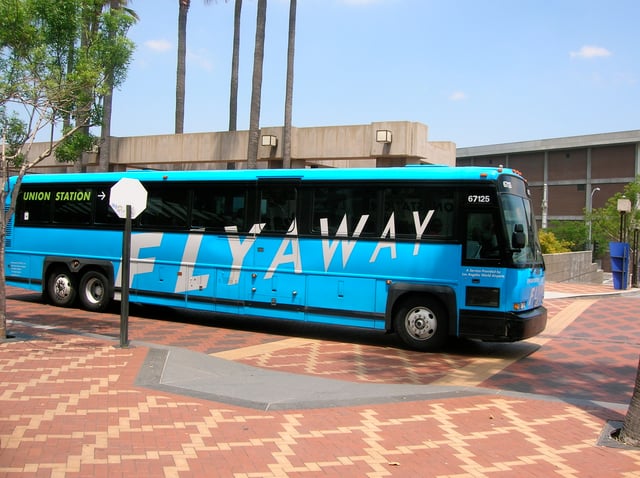
FlyAway Bus at Los Angeles Union Station
The FlyAway Bus is a nonstop motorcoach/shuttle service run by the LAWA, which provides scheduled service between LAX and Downtown Los Angeles (Union Station), the San Fernando Valley (Van Nuys), Hollywood, and Long Beach.[152] The shuttle service stops at every LAX terminal. The service hours vary based on the line. All lines use the regional system of High Occupancy Vehicle lanes to expedite their trips. The Los Angeles Union Station service and a late-night branch of Metro Local route 40 are the only direct transit links between the airport and Downtown Los Angeles.
Discontinued routes for the FlyAway include West Los Angeles (Westwood), Santa Monica, and Irvine.
Metro Rail
Shuttle bus "G" offers a free connection to and from the Aviation/LAX station on the Los Angeles Metro Rail Green Line. The line was originally intended to be a people mover to connect directly to the airport terminals, but budgetary restraints and opposition from local taxi and parking lot owners impeded its progress and won.
LAX Train
An automated people mover (APM) system is an under construction train by LAWA. The LAX APM will have six stations and be 2.25 miles in traveling distance: three stations serving the central area, terminals 1–8 and the Tom Bradley International Terminal.[153]
Heading east, the first station is a ground transportation parking structure called the "Intermodal Transportation Facility-West" that will serve employee parking, surrounding hotels access and long term airport parking. The next station will be above a ground infill transit transfer station on the LAX/Crenshaw Metro Line. At this station, the first (floor) level will be a second car/bus/bike transport facility called the "Intermodal Transport Facility-East" as well as LA Metro Rail's platform. The second level will be a bridge from the main hub to the light rail platform and APM platform with fare gates. The third level will be the APM. The last stop will be a rental car hub station called the Consolidated Rent-A-Car-Center (CONRAC).[154] All the car rental companies and rentals will be here. The APM was designed to decrease the need for shuttle bus services and reduce traffic within the terminals World Way. The APM will have nine total trains, each operating in four car sets with capacity of containing up to 200 passengers. The APM will operate every two minutes, with a ten minute end-to-end travel time.[155]
Los Angeles had bid for the 2024 Summer Olympics in 2016 and was one of two city finalists, due to decreasing demand to host the Olympics, the IOC awarded both Los Angeles and the city of Paris with Olympic games each, Los Angeles being awarded the latter, the 2028 Summer Olympics. The project will be completed in time for the 2028 Summer Olympics in 2023 as its original projected completion date was by 2024 before the awarding. They choose to retain the original deadline.[156][157] LAWA has split the project in three phases. The project has been approved and the construction and operating bidding process was commenced.[158] Three firms submitted bids and LAWA announced scoring for the project would be based on "technical merit, visual appeal, user experience and price".[159] LAWA proposed a public private partnership wherein a private sector partner would responsible for the construction and operation of the people mover.[160] Los Angeles City Council gave final approval on April 11, 2018 to "LAX Integrated Express Solutions". The joint bid that included manufacturer Bombardier Transportation at 4.895 Billion over 30 years to build and operate.[161] The three phase project is estimated to cost $5.5 billion,[162][163] and have a completion date of 2023.
Construction
- Phase 1
Dallas based building firm Austin Commercial was awarded a five year contract to commence construction in the first quarter of 2018 on phase one of the APM project. The project consists of bridges to connect passengers between the three proposed APM stations inside World Way and the terminals. The bridges will also house restrooms, Airport lounges offices and other spaces. The project is expected to finish by 2021, followed by phases two and three that will consist of the people mover and off site buildings.[164] In January 2018, a consortium led by Hochtief and Bombardier Transportation was selected as the preferred developer to be awarded the $1.95 billion design/build/operate contract.[165]
- Phase 2
In 2018, 2,100 parking spaces in lot C were removed to reconfigure the area for phase two, the parking structures.[163] Utility relocation started in the second quarter of 2018.[155] The guideway started construction in spring 2019,[155] It will take up to three years to complete. Groundbreaking was held in March 2019.[166] The "Intermodal Transportation Facility - West" began construction in summer of 2019.[167] The Consolidated Car Rental Facility "CONRAC" broke ground on September 2019.[168]
Taxis and private shuttles
Taxicab services are operated by nine city-authorized taxi companies and regulated by Authorized Taxicab Supervision Inc. (ATS). ATS maintains a taxicab holding lot under the 96th Street Bridge where, at peak periods, hundreds of cabs queue up to wait their turn to pull into the central terminal area to pick up passengers. A number of private shuttle companies also offer limousine and bus services to LAX Airport.
Uber and Lyft both provide ride services to and from LAX.[169] All dropoffs and pickups happen on the upper departures level. Pickups (arriving passengers) only happen at one of the designated "rideshare signs." There are six rideshare sign locations around the airport, labeled A thru F. Lyft and Uber drivers are not allowed on the lower arrivals area, except when picking up a disabled passenger who requires ADA access. Uber and Lyft drivers must have a valid LAX placard displayed on the passenger side of their vehicle's inside front windshield or dashboard. LAX charges a $4 fee for every ride to and from LAX using Lyft or Uber. This fee is billed to the rider, and is included in the estimate before the rider accepts the fare and sends out the request.
Coast Guard Air Station Los Angeles
The airport also functioned as a joint civil-military facility, providing a base for the United States Coast Guard and its Coast Guard Air Station Los Angeles facility, operating four HH-65 Dolphin helicopters, which covers Coast Guard operations in various Southern California locations, including Catalina Island. Missions include search and rescue (SAR), law enforcement, aids to navigation support (such as operating lighthouses) and various military operations. In addition, Coast Guard helicopters assigned to the air station deploy to Coast Guard cutters.
The air station relocated by May 18, 2016 from LAX to accommodate the planned improvements for LAX's midfield, including the Midfield Satellite Concourse North (MSC North) terminal. The air station moved to U.S. Navy's Naval Air Station Point Mugu, part of the Naval Base Ventura County (NBVC) in Point Mugu.[170]
Flight Path Learning Center & Museum
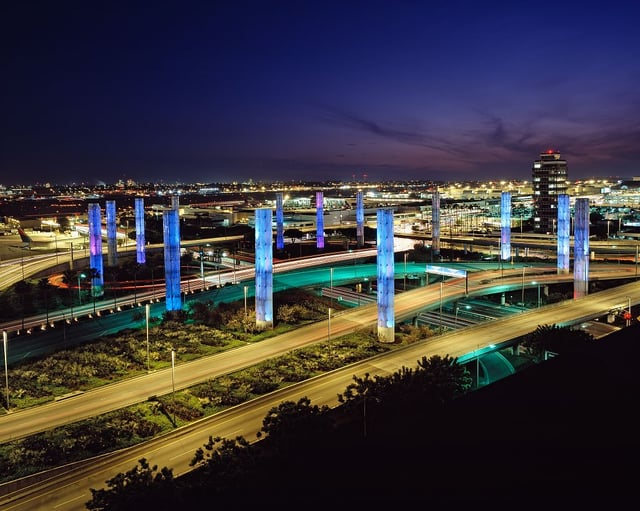
The light towers, first installed in preparation for the Democratic National Convention in 2000, change colors throughout the night
The Flight Path Learning Center is a museum located at 6661 Imperial Highway and was formerly known as the "West Imperial Terminal". This building used to house some charter flights (e.g. Condor Airlines, Martinair Holland, World Airways) and regular scheduled flights by MGM Grand Air. It sat empty for 10 years until it was re-opened as a learning center for LAX.
The center contains information on the history of aviation, several pictures of the airport, as well as aircraft scale models, flight attendant uniforms, and general airline memorabilia such as playing cards, china, magazines, signs, even a TWA gate information sign. The museum also offers school tours and a guest speaker program.
The museum's library contains an extensive collection of rare items such as aircraft manufacturer company newsletters/magazines, technical manuals for both military and civilian aircraft, industry magazines dating back to World War II and before, historic photographs and other invaluable references on aircraft operation and manufacturing.[171]
The museum has on display "The Spirit of Seventy-Six," which is a DC-3 (DC-3-262, Serial No. 3269). After being in commercial airline service, the plane served as a corporate aircraft for Union Oil Company for 32 years. The plane was built in the Douglas Aircraft Company plant in Santa Monica in January 1941, which was a major producer of both commercial and military aircraft.[172]
The museum claims to be "the only aviation museum and research center situated at a major airport and the only facility with a primary emphasis on contributions of civil aviation to the history and development of Southern California".[173] There are other museums at major airports, however, including the Udvar-Hazy Center of the National Air and Space Museum adjacent to Washington Dulles Airport, the Royal Thai Air Force Museum at Don Mueang Airport, the Suomen ilmailumuseo (Finnish Aviation Museum) at Helsinki-Vantaa Airport, the Frontiers of Flight Museum at Dallas Love Field, the Tulsa Air and Space Museum & Planetarium at Tulsa International Airport and others.
Other facilities
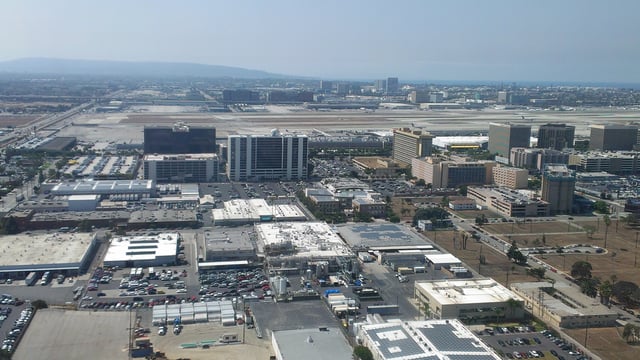
Hotels next to LAX
The airport has the administrative offices of Los Angeles World Airports.[174]
Continental Airlines once had its corporate headquarters on the airport property. At a 1962 press conference in the office of Mayor of Los Angeles Sam Yorty, Continental Airlines announced that it planned to move its headquarters to Los Angeles in July 1963.[175] In 1963 Continental Airlines headquarters moved to a two-story, $2.3 million building on the grounds of the airport.[176][177] The July 2009 Continental Magazine issue stated that the move "underlined Continental Airlines western and Pacific orientation".[178] On July 1, 1983 the airline's headquarters were relocated to the America Tower in the Neartown area of Houston.[179]
Accidents and incidents

LAX Airport Response Coordination Center used to coordinate emergency response
During its history there have been numerous incidents, but only the most notable are summarized below:[182]
1930s
On January 23, 1939, the sole prototype Douglas 7B twin-engine attack bomber, designed and built as a company project, suffered a loss of the vertical fin and rudder during a demonstration flight over Mines Field, flat spun into the parking lot of North American Aviation, and burned. Another source states that the test pilot, in an attempt to impress the Gallic passenger, attempted a snap roll at low altitude with one engine feathered, resulting in the fatal spin.[183] Douglas test pilot Johnny Cable bailed out at 300 feet, his chute unfurled but did not have time to deploy, he was killed on impact, the flight engineer John Parks rode in the airframe and died, but 33-year-old French Air Force Capt. Paul Chemidlin, riding in the aft fuselage near the top turret, survived with a broken leg, severe back injuries, and a slight concussion. The presence of Chemidlin, a representative of a foreign purchasing mission, caused a furor in Congress by isolationists over neutrality and export laws. The type was developed as the Douglas DB-7.[184]
1940s
On June 1, 1940, the first Douglas R3D-1 for the U.S. Navy, BuNo 1901, crashed at Mines Field, before delivery. The Navy later acquired the privately owned DC-5 prototype, from William E. Boeing as a replacement.[185]
On November 20, 1940, the prototype NA-73X Mustang, NX19998,[186] first flown October 26, 1940, by test pilot Vance Breese, crashed this date.[187] According to P-51 designer Edgar Schmued, the NA-73 was lost because test pilot Paul Balfour refused, before a high-speed test run, to go through the takeoff and flight test procedure with Schmued while the aircraft was on the ground, claiming "one airplane was like another". After making two high speed passes over Mines Field, he forgot to put the fuel valve on "reserve" and during the third pass ran out of fuel. An emergency landing in a freshly plowed field caused the wheels to dig in, the aircraft flipped over, the airframe was not rebuilt, the second aircraft being used for subsequent testing.[188]
On October 26, 1944, WASP pilot Gertrude Tompkins Silver of the 601st Ferrying Squadron, 5th Ferrying Group, Love Field, Dallas, Texas, departed Los Angeles Airport, in a North American P-51D Mustang, 44-15669,[189] at 1600 hrs PWT, headed for the East Coast. She took off into the wind, into an offshore fog bank, and was expected that night at Palm Springs. She never arrived. Due to a paperwork foul-up, a search did not get under way for several days, and while the eventual search of land and sea was massive, it failed to find a trace of Silver or her plane. She is the only missing WASP pilot. She had married Sgt. Henry Silver one month before her disappearance.[190]
1960s
On January 13, 1969, Scandinavian Airlines System Flight 933 Douglas DC-8-62, crashed into Santa Monica Bay, approximately 6 nautical miles (11 km) west of LAX at 7:21 pm, local time. The aircraft was operating as flight SK-933, nearing the completion of a flight from Seattle. Of nine crewmembers, three lost their lives to drowning, while 12 of the 36 passengers also drowned.
On January 18, 1969, United Airlines Flight 266 a Boeing 727-200 bearing the registration number N7434U, crashed into Santa Monica Bay approximately 11.3 miles (18.2 km) west of LAX at 6:21 pm local time. The aircraft was destroyed, resulting in the loss of all 32 passengers and six crew members aboard.
1970s
On the evening of June 6, 1971, Hughes Airwest Flight 706, a Douglas DC-9 jetliner that had departed LAX on a flight to Salt Lake City, Utah, was struck nine minutes after takeoff by a U.S. Marine Corps McDonnell Douglas F-4 Phantom II fighter jet over the San Gabriel Mountains. The midair collision killed all 44 passengers and five crew members aboard the DC-9 airliner and one of two crewmen aboard the military jet.
On August 6, 1974, a bomb exploded near the Pan Am ticketing area at Terminal 2; three people were killed and 35 were injured.[191]
On March 1, 1978, two tires burst in succession on a McDonnell Douglas DC-10-10 on Continental Airlines Flight 603 during its takeoff roll at LAX and the plane, bound for Honolulu, veered off the runway. A third tire burst and the DC-10's left landing gear collapsed, causing a fuel tank to rupture. Following the aborted takeoff, spilled fuel ignited and enveloped the center portion of the aircraft in flames. During the ensuing emergency evacuation, a husband and wife died when they exited the passenger cabin onto the wing and dropped down directly into the flames. Two additional passengers died of their injuries approximately three months after the accident; 74 others aboard the plane were injured, as were 11 firemen battling the fire.
On the evening of March 10, 1979, Swift Aire Flight 235, a twin-engine Aerospatiale Nord 262A-33 turboprop en route to Santa Maria, was forced to ditch in Santa Monica Bay after experiencing engine problems upon takeoff from LAX. The pilot, co-pilot and a female passenger drowned when they were unable to exit the aircraft after the ditching. The female flight attendant and the three remaining passengers—two men and a pregnant woman—survived and were rescued by several pleasure boats and other watercraft in the vicinity.
1980s
On August 31, 1986, Aeroméxico Flight 498, a DC-9 en route from Mexico City, Mexico to Los Angeles, began its descent into LAX when a Piper Cherokee collided with the DC-9's left horizontal stabilizer over Cerritos, causing the DC-9 to crash into a residential neighborhood. All 67 people on the two aircraft were killed, in addition to 15 people on the ground. 5 homes were destroyed and an additional 7 were damaged by the crash and resulting fire. The Piper went down in a nearby schoolyard and caused no further injuries on the ground. As a result of this incident, the FAA required all commercial aircraft to be equipped with Traffic Collision Avoidance System (TCAS).
1990s
On February 1, 1991, USAir Flight 1493 (arriving from Columbus, Ohio), a Boeing 737-300, landing on runway 24L at LAX, collided on touchdown with a SkyWest Airlines Fairchild Metroliner, Flight 5569 departing to Palmdale. The Skywest plane was given clearance to wait on the runway for takeoff. The same controller then gave the USAir plane clearance to land on the same runway, forgetting that the SkyWest plane was there. The collision killed all 12 occupants of the SkyWest plane and 23 people aboard the USAir 737.[192][193]
2000s
Al-Qaeda attempted to bomb LAX on New Year's Eve 1999/2000. The bomber, Algerian Ahmed Ressam, was captured in Port Angeles, Washington, the U.S. port of entry, with a cache of explosives that could have produced a blast 40 times greater than that of a car bomb hidden in the trunk of the rented car in which he had traveled from Canada.[194][195] He had planned to leave one or two suitcases filled with explosives in an LAX passenger waiting area.[196][197] He was initially sentenced to 22 years in prison, but in February 2010 an appellate court ordered that his sentence be extended.[198]
On January 31, 2000, Alaska Airlines Flight 261, a McDonnell Douglas MD-83 jetliner flying from Puerto Vallarta, Mexico to San Francisco and Seattle, requested an emergency landing at LAX after experiencing problems with its tail-mounted horizontal stabilizer. Before the plane could divert to Los Angeles, it suddenly plummeted into the Pacific Ocean approximately 2.7 miles (4.3 km) north of Anacapa Island off the California coast, killing all 88 people aboard.[199]
Three of the four planes hijacked on September 11, 2001 were bound for LAX.
In the 2002 Los Angeles International Airport shooting of July 4, 2002, Hesham Mohamed Hadayet killed two Israelis at the ticket counter of El Al Airlines at LAX. Although the gunman was not linked to any terrorist group, the man was upset at U.S. support for Israel, and therefore was motivated by political disagreement. This led the FBI to classify this shooting as a terrorist act,[200] one of the few on U.S. soil since the September 11 attacks.
On September 21, 2005, JetBlue Flight 292, an Airbus A320 discovered a problem with its landing gear as it took off from Bob Hope Airport in Burbank. It flew in circles for three hours to burn off fuel, then landed safely at Los Angeles International Airport on runway 25L, balancing on its back wheels as it rolled down the center of the runway. Passengers were able to watch their own coverage live from the satellite broadcast on JetBlue in-flight TV seat displays of their plane as it made an emergency landing with the front landing gear visibly becoming damaged. Because JetBlue did not serve LAX at the time, the aircraft was evaluated and repaired at a Continental Airlines hangar.[201][202]
On July 29, 2006, after America West Express Flight 6008, a Canadair Regional Jet operated by Mesa Airlines from Phoenix, Arizona, landed on runway 25L, controllers instructed the pilot to leave the runway on a taxiway known as "Mike" and stop short of runway 25R. Even though the pilot read back the instructions correctly, he accidentally taxied onto 25R and into the path of a departing SkyWest Airlines Embraer EMB-120 operating United Express Flight 6037 to Monterey. They cleared each other by 50 feet (15 m) and nobody was hurt.[203]
On August 16, 2007, a runway incursion occurred between WestJet Flight 900 and Northwest Airlines Flight 180 on runways 24R and 24L, respectively, with the aircraft coming within 37 feet (11 m) of each other. The planes were carrying a combined total of 296 people, none of whom were injured. The NTSB concluded that the incursion was the result of controller error.[204] In September 2007, FAA Administrator Marion Blakey stressed the need for LAX to increase lateral separation between its pair of north runways in order to preserve the safety and efficiency of the airport.[205]
2010s
On October 13 and 14, 2013, two incidents of dry ice bomb explosions occurred at the airport. The first dry ice bomb exploded at 7:00 p.m. in an employee restroom in Terminal 2, with no injuries. Terminal 2 was briefly shut down as a result. On the next day at 8:30 p.m., a dry ice bomb exploded on the ramp area near the Tom Bradley International Terminal, also without injuries. Two other plastic bottles containing dry ice were found at the scene during the second explosion. On October 15, a 28-year-old airport employee was arrested in connection with the explosions and was booked on charges of possession of an explosive or destructive device near an aircraft. He is currently held on a $1 million bail.[206][207][208] On October 18, a 41-year-old airport employee was arrested in connection with the second explosion, and was booked on suspicion of possessing a destructive device near an aircraft.[209] Authorities believe that the incidents are not linked to terrorism.[206]
In the 2013 Los Angeles International Airport shooting of November 1, 2013, at around 9:31 a.m. PDT, a lone gunman entered Terminal 3 and opened fire with a semi-automatic rifle, killing a Transportation Security Administration (TSA) officer and wounding three other people. The gunman was later apprehended and taken into custody. Until the situation was clarified and under control, a few terminals at the airport were evacuated, all inbound flights were diverted and all outbound flights were grounded until the airport began returning to normal operation at around 2:30 p.m.[210][211]
On August 28, 2016, there was a false report of shots fired throughout the airport, causing a temporary lock down and about 3 hours of flight delays.[212]
On May 20, 2017, Aeroméxico Flight 642, a Boeing 737-800, collided with a utility truck on a taxiway near Runway 25R, injuring 8 people, two of them seriously.[213]
Planned modernization project
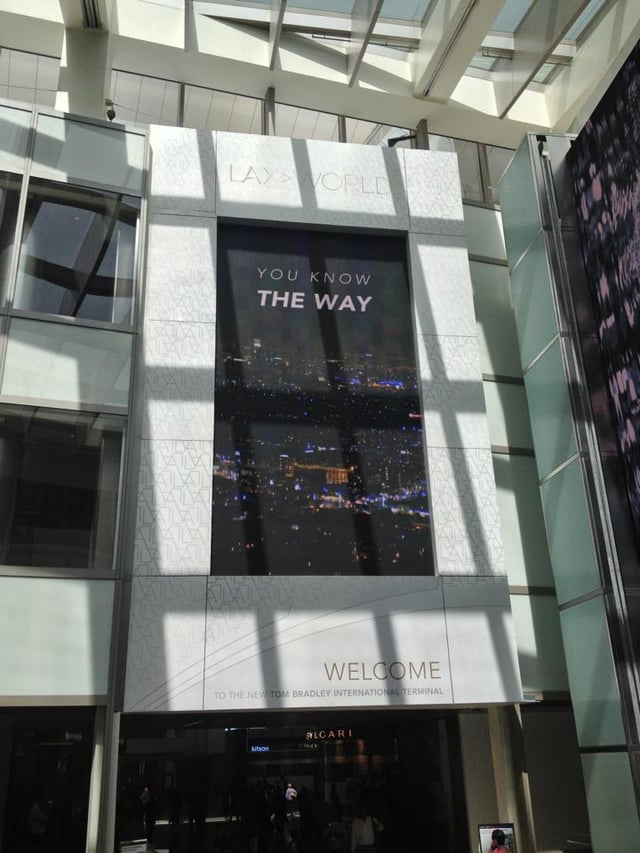
New Tom Bradley West International Terminal "Bon Voyage" screen that greets travelers about to depart through the expanded concourse
LAWA currently has several plans to modernize LAX. These include terminal and runway improvements, which will enhance the passenger experience, reduce overcrowding, and provide airport access to the latest class of very large passenger aircraft.
These improvements include:[214]
New crossfield taxiway
New large aircraft gates at Tom Bradley International Terminal (TBIT)
TBIT core improvements
$1.3 Billion "Midfield Satellite Concourse North" adding 12 gates.[215]
Replacement of Central Utility Plant
Terminal and Runway Improvements
New terminal "9" east of Sepulveda Boulevard[216] and Concourse "0" east of terminal 1.[217]
A 24-hour automated people mover is under construction. This small train will include three stations in the central terminal area and three outside east of the terminals at a new intermodal transportation facility hub, connecting passengers between the central terminal area and the Metro Green Line, the future Metro Crenshaw/LAX Line regional and local bus lines and a consolidated car rental facility.[218][219]
In popular culture
Numerous films and television shows have been set or filmed partially at LAX, at least partly due to the airport's proximity to Hollywood studios and Los Angeles. Film shoots at the Los Angeles airports, including LAX, produced $590 million for the Los Angeles region from 2002 to 2005.[220]
See also
California World War II Army Airfields
List of airports in the Los Angeles area
Metro
Los Angeles Airport Police
Peirson Mitchell Hall

